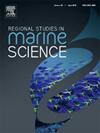Regional disparities in marine carbon sink development in china: From an opportunity inequality perspective
IF 2.4
4区 环境科学与生态学
Q3 ECOLOGY
引用次数: 0
Abstract
Based on the theory of opportunity inequality, this study constructs an analytical framework encompassing nine opportunity inequality factors including national policies, demand dynamics, and talent support. Utilizing the MLD index and Shapley value decomposition method, we quantify the ocean carbon sink opportunity inequality index and its spatiotemporal differentiation characteristics across three major marine economic circles (northern, eastern, and Southern) from 2010 to 2022. The findings reveal that: (1) Temporospatial analysis demonstrates an overall fluctuating upward trend in opportunity inequality indices. The northern Marine Economic Circle exhibits the highest and continuously rising inequality index, followed by the southern Circle with significant growth, while the eastern circle maintains the lowest and relatively stable index. (2) Factor decomposition identifies national policies, demand dynamics, and coastline resources as key dynamic contributors to regional disparities in marine carbon sink development, though their relative contributions display temporal variability. (3) Mechanism analysis reveals that opportunity inequality factors indirectly amplify regional disparities through local blue carbon financial policies and factor inputs. The northern Circle demonstrates predominant influences from marine innovation investment and regional blue carbon policies, the southern circle shows highest contributions from marine environmental factors, while the eastern circle is primarily affected by marine innovation investment. Accordingly, this study proposes policy recommendations including establishing differentiated blue carbon financial support systems, enhancing policy coordination, and strengthening technological R&D and talent cultivation in marine carbon sinks, aiming to promote regional equity and achieve the dual carbon goals.
中国海洋碳汇发展的区域差异:基于机会不平等的视角
基于机会不平等理论,构建了包含国家政策、需求动态、人才支持等9个因素的机会不平等分析框架。利用MLD指数和Shapley值分解方法,量化了2010 - 2022年中国海洋碳汇机会不平等指数及其在北、东、南三大海洋经济圈的时空分异特征。结果表明:(1)从时空分析来看,机会不平等指数总体呈波动上升趋势。北部海洋经济圈不平等指数最高且持续上升,其次是南部海洋经济圈,增长显著,东部海洋经济圈不平等指数最低且相对稳定。(2)因子分解发现,国家政策、需求动态和海岸线资源是海洋碳汇发展区域差异的关键动态因素,但它们的相对贡献表现出时间变异性。(3)机制分析表明,机会不平等因素通过地方蓝碳金融政策和要素投入间接放大区域差异。北部环受海洋创新投资和区域蓝碳政策的影响最大,南部环受海洋环境因素的影响最大,东部环主要受海洋创新投资的影响。为此,本研究提出了建立差异化的蓝碳金融支持体系、加强政策协调、加强海洋碳汇的技术研发和人才培养等政策建议,以促进区域公平,实现双碳目标。
本文章由计算机程序翻译,如有差异,请以英文原文为准。
求助全文
约1分钟内获得全文
求助全文
来源期刊

Regional Studies in Marine Science
Agricultural and Biological Sciences-Ecology, Evolution, Behavior and Systematics
CiteScore
3.90
自引率
4.80%
发文量
336
审稿时长
69 days
期刊介绍:
REGIONAL STUDIES IN MARINE SCIENCE will publish scientifically sound papers on regional aspects of maritime and marine resources in estuaries, coastal zones, continental shelf, the seas and oceans.
 求助内容:
求助内容: 应助结果提醒方式:
应助结果提醒方式:


